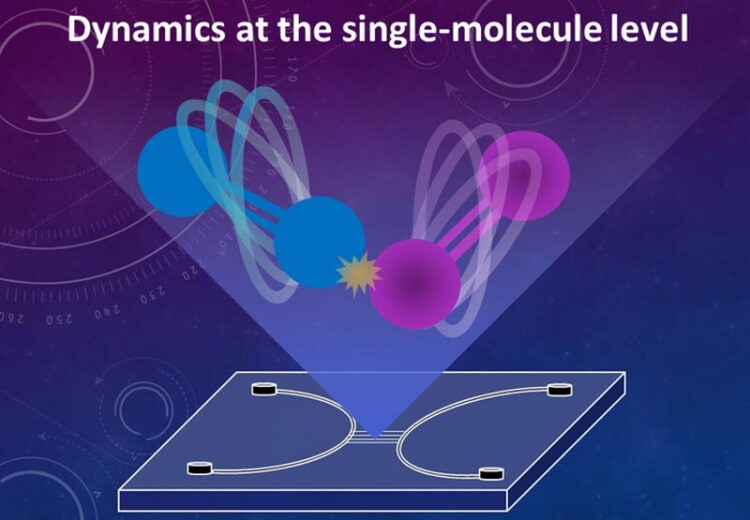Nanofluidic devices offer solutions for studying single molecule chemical reactions

The moment two single molecules trapped in the nanofluidic device collide allowing them to react with each other.
Credit: Yan Xu, Osaka Metropolitan University
In a chemical reaction, molecules in different substances meet one another to form new molecules causing changes in the bonds of their atoms. The molecules collide at an extremely close distance—a nanometer or less—in an extremely short amount of time. This makes investigating the details of chemical reactions at the molecular scale difficult. Most experimental knowledge, used to explain single-molecule reaction dynamics, was obtained by studying reactions in gases. However, the overwhelming majority of chemical reactions take place in liquids, so elucidating single-molecule reaction dynamics in solution is an important challenge, with very few experimental tools.
A nanofluidic device—a few square centimeters of glass plate with nanometer-sized nanofluidic channels carved into it—provides a test tube-like environment to confine individual molecules. But nanofluidic devices have the potential to be used in combination with various existing analytical instruments with high temporal resolution, to investigate extremely fast single molecule reactions.
The authors of the review, Associate Professor Yan Xu and Dr. Nattapong Chantipmanee of the Osaka Metropolitan University Graduate School of Engineering, have engineered principles and technologies to freely manipulate nanomaterials, biomaterials, and molecules at the single-molecule level. The methodologies covered by their review use fundamental technologies such as nanofluidic processing, functional integration, and fluidic control and measurement, pioneering the way to integrate various fields by using nanofluidics. In addition, to elucidate the single molecule dynamics of reactions in solution using their unique nanofluidic devices, they are working to solve problems such as how to precisely manipulate small molecules in solution and how to measure their extremely quick—nano- to picosecond—reactions.
The researchers published their review article on single-molecule reaction dynamics in solution pioneered by nanofluidic devices, in the January 2023 issue of TrAC Trends in Analytical Chemistry. As pioneers in this new field, the review provides a bird’s eye view, including the forefront of research and development, future challenges, and where new these discoveries may lead.
“Nanofluidic devices have the potential to become a fantastic experimental tool to elucidate the dynamics of solution reactions. I hope this paper will encourage more researchers to join this budding field of research,” said Professor Xu.
About OMU
Osaka Metropolitan University is a new public university established in April 2022, formed by merger between Osaka City University and Osaka Prefecture University. For more research news visit https://www.omu.ac.jp/en/ or follow @OsakaMetUniv_en and #OMUScience.
Journal: TrAC Trends in Analytical Chemistry
DOI: 10.1016/j.trac.2022.116877
Method of Research: Literature review
Subject of Research: Not applicable
Article Title: Nanofluidics for chemical and biological dynamics in solution at the single molecular level
Article Publication Date: 7-Dec-2022
Media Contact
Yoshiko Tani
Osaka Metropolitan University
koho-ipro@ml.omu.ac.jp
All latest news from the category: Materials Sciences
Materials management deals with the research, development, manufacturing and processing of raw and industrial materials. Key aspects here are biological and medical issues, which play an increasingly important role in this field.
innovations-report offers in-depth articles related to the development and application of materials and the structure and properties of new materials.
Newest articles

High-energy-density aqueous battery based on halogen multi-electron transfer
Traditional non-aqueous lithium-ion batteries have a high energy density, but their safety is compromised due to the flammable organic electrolytes they utilize. Aqueous batteries use water as the solvent for…

First-ever combined heart pump and pig kidney transplant
…gives new hope to patient with terminal illness. Surgeons at NYU Langone Health performed the first-ever combined mechanical heart pump and gene-edited pig kidney transplant surgery in a 54-year-old woman…

Biophysics: Testing how well biomarkers work
LMU researchers have developed a method to determine how reliably target proteins can be labeled using super-resolution fluorescence microscopy. Modern microscopy techniques make it possible to examine the inner workings…





















